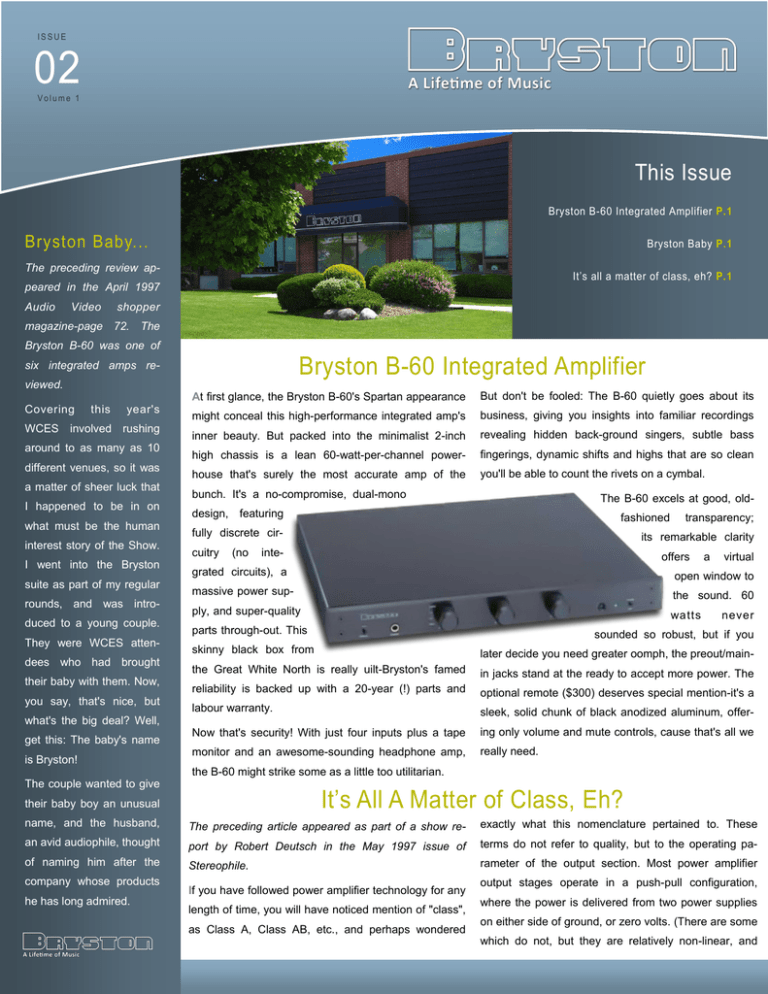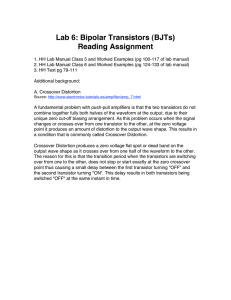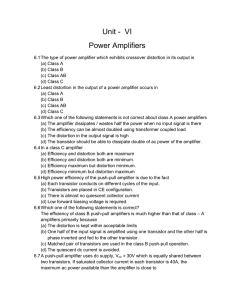Bryston B-60 Integrated Amplifier It`s All A Matter of Class, Eh?
advertisement

ISSUE 02 Volume 1 This Issue Bryston B-60 Integrated Amplifier P.1 Bryston Baby... Bryston Baby P.1 The preceding review ap- It’s all a matter of class, eh? P.1 peared in the April 1997 Audio Video shopper magazine-page 72. The Bryston B-60 was one of Bryston B-60 Integrated Amplifier six integrated amps reviewed. Covering WCES this year's involved rushing around to as many as 10 different venues, so it was a matter of sheer luck that I happened to be in on what must be the human interest story of the Show. I went into the Bryston suite as part of my regular rounds, and was introduced to a young couple. They were WCES attendees who had brought their baby with them. Now, you say, that's nice, but what's the big deal? Well, get this: The baby's name is Bryston! The couple wanted to give At first glance, the Bryston B-60's Spartan appearance But don't be fooled: The B-60 quietly goes about its might conceal this high-performance integrated amp's business, giving you insights into familiar recordings inner beauty. But packed into the minimalist 2-inch revealing hidden back-ground singers, subtle bass high chassis is a lean 60-watt-per-channel power- fingerings, dynamic shifts and highs that are so clean house that's surely the most accurate amp of the you'll be able to count the rivets on a cymbal. bunch. It's a no-compromise, dual-mono The B-60 excels at good, old- design, featuring fashioned fully discrete circuitry (no transparency; its remarkable clarity inte- offers a virtual grated circuits), a open window to massive power sup- the sound. 60 ply, and super-quality watts parts through-out. This never sounded so robust, but if you skinny black box from later decide you need greater oomph, the preout/main- the Great White North is really uilt-Bryston's famed in jacks stand at the ready to accept more power. The reliability is backed up with a 20-year (!) parts and optional remote ($300) deserves special mention-it's a labour warranty. sleek, solid chunk of black anodized aluminum, offer- Now that's security! With just four inputs plus a tape ing only volume and mute controls, cause that's all we monitor and an awesome-sounding headphone amp, really need. the B-60 might strike some as a little too utilitarian. It’s All A Matter of Class, Eh? their baby boy an unusual name, and the husband, The preceding article appeared as part of a show re- exactly what this nomenclature pertained to. These an avid audiophile, thought port by Robert Deutsch in the May 1997 issue of terms do not refer to quality, but to the operating pa- of naming him after the Stereophile. rameter of the output section. Most power amplifier company whose products he has long admired. If you have followed power amplifier technology for any length of time, you will have noticed mention of "class", as Class A, Class AB, etc., and perhaps wondered output stages operate in a push-pull configuration, where the power is delivered from two power supplies on either side of ground, or zero volts. (There are some which do not, but they are relatively non-linear, and Bryston (the company) was so delighted that Bryston (the baby) is getting one of the new B-60 integrated amps as a present. Twomonth-old Bryston (it is a great name, isn't it?) was looking around, alert and bright-eyed, obviously im- pressed with the sound of the PMC speakers that "Uncle Bryston" is distributing. need not be considered here). Some engineers prefer not to have to deal with the pos- Operating in push-pull, the output transistors share the sibility of crossover distortion in their designs, and they load, and are theoretically required to do work only as choose another bias system, called "Class A", where the signal swings away from ground, in either the posi- the output transistors are biased on so much that they tive or negative direction. If the transistors are com- continuously conduct more than the full load current, pletely switched off at zero output, and only start con- even at idle. Thus, they never turn "on" or "off', theoretiducting when signal is present, this is defined as Class cally obviating crossover distortion. B operation. This is an efficient way of operating the Unfortunately, this operating system has some obvious, output, and the amplifier runs cool at no signal, but (and some not-so-obvious), disadvantages. Running there is one disadvantage; The output devices always that much current generates a tremendous amount of have some lag time in their operation, and thus there heat, so the amplifier is not just inefficient, it is large and appears a small but potentially annoying dead zone, expensive, due to the huge heat-dissipating mechacalled "crossover distortion", at the zero point. Although nisms required. This consequently warms up the whole this crossover nonlinearity does not necessarily add room as a side-effect. (Nice in the winter, but remember large amounts to the distortion numbers, (0.05% is electric heat is the most expensive kind there is). probably typical), it is easy to is that hear. A not-so-obvious disadvantage with class A designs is Fortunately, crossover distortion can be reduced to neg- that this high idling current has consequences to the ligible proportions by the simple expedient of running distortion levels far beyond the theoretical elimination of the output transistors "biased" slightly "on" at idle, so crossover artefacts, (which even in itself is debatable). they start conducting before the output swings through Transistors have numerous types of distortion mechathe zero point. When an amplifier runs this biased out- nisms, among which are deviations from linearity under put mechanism, it is referred to as "Class AB". Moder- conditions of simultaneous high voltage and high curate amounts of bias are all that is needed, and as it rent. These are, of course, the exact parameters necesproduces only a bit of heat, this type of amp is still rea- sary to class A operation, and a typical Class A amplisonably efficient. Crossover distortion has a number of fier runs distortion levels at least 10 times, and often ways to pop up its ugly little head, however, even if over 100 times, as high as a Class AB amplifier of simithere is a fair amount of bias present, so the engineer- lar power, or around 0.1%. A careful inspection pf the ing of this type of amplifier must be very exacting and distortion spectrum also reveals that all the 'harmonics precise to give the lowest distortion at all frequencies. If are increased, including those represented by the done properly, however, there is no more accurate or crossover distortion at which the class A operation was lower-distortion type of amplifier available; 0.01% is aimed in the first place! typical, and 0.001% is attainable. Going in the other direction, Class D offers high effi- ciency through a very different approach to output op- around 0.1% or so. If efficiency is your requirement, eration. Class D, often erroneously thought of as "digital though, this is the way to go. amplification", is actually an analog system which varies Next time, we will look into some other classes of amplithe width of the top-versus-bottom duty-cycle of a fication, such as class H, or variable power supply, as square wave carrier frequency. The amplifier still trav- well as some interesting "combination" classes, to see if erses from negative to positive voltages and back some of them might have merit. again, but does so continuously, at a high frequency of perhaps 500 kHz. The time it spends at one extreme or the other is proportional to the locus, or exact voltagetime relationship, of the desired signal at that moment. Since the output devices spend almost all their time at either full-on or full-off, (areas of absolute minimal dissipation), efficiency is very high, from 80 to 90%. Thus, these amplifiers produce very little heat, and do not have to be as heavy or as large as typical class AB amplifiers, (to say nothing of the class A monsters)! There are naturally disadvantages as well. Class D, by definition, uses very large RF signals, and must be shielded and well-filtered to prevent interference and speakerdamaging outputs. This in turn harms overall linearity, as well as adding to the cost, thus this is not an inexpensive technology. The overall distortion is usually on a par with Class A amplification; good but not great, at Bryston Ltd. 677 Neal Drive Peterborough, Ontario CANADA K9J 6X7 Phone: 705-742-5325 or 1-800-632-8217 Fax: 705-742-0882 Email: contact@bryston.com Web: http://www.bryston.com Editor: James Tanner, Vice President of Sales and Marketing Email: jamestanner@bryston.com



